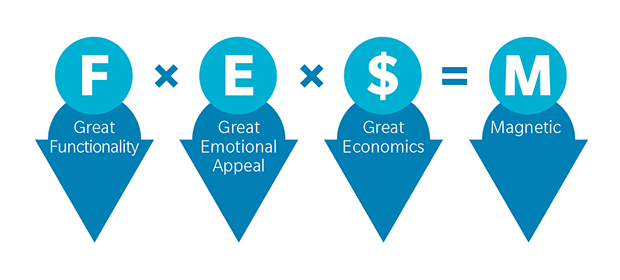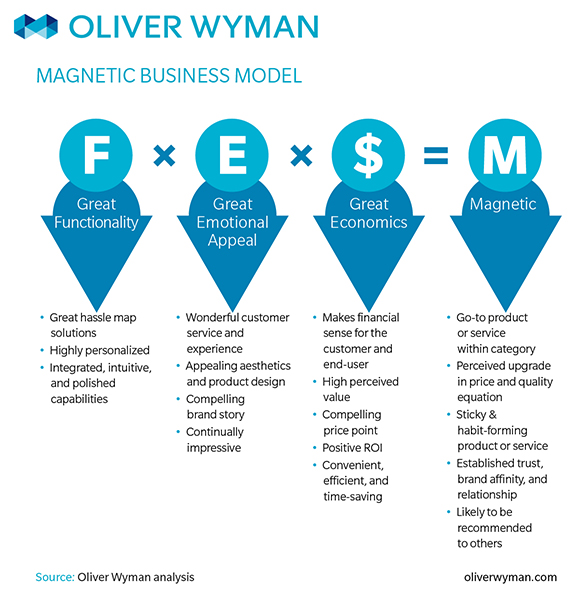In the past, winning with the consumer was about being the best of the worst, because they were spending someone else’s healthcare dollars. What’s different this time?
With high deductible health plans, it’s the consumer’s money. Consumers are making tradeoffs between healthcare, rent, their iPhone bill, transportation, and recreation. That fundamentally changes the dynamic, and it’s becoming increasingly difficult for healthcare players to thrive by simply being the best of the worst.
As more consumers sort through the noisy, crowded health marketplace, it becomes critically important to create products and solutions that are "magnetic." Magnetic offers are at the core of a successful and sustainable consumer-centered business. Think F+E+$=M (Functionality + Emotional Appeal + Economics = Magnetic Product).
Let’s say you’re a health plan looking to engage employees and manage their medical cost spend. It’s tough to start by solving medical cost reduction – consumers don’t know you, don’t trust you, and are unlikely to engage with you until you offer something that shows them real or perceived value. One approach is to use the F+E+$=M framework:
Functionality
What burning consumer problem are you going to solve? What hassles are you going to eliminate? What JOB is the consumer going to have you do, and how will you execute against and deliver that?
Emotional Appeal
It’s not just the rational meeting of a consumer’s need, it’s the establishment of a deep emotional connection. The emotional connection not only makes you stickier, but consumers with an emotional connection to you are more forgiving – it gives you permission to fail (e.g. Southwest still has cancelled flights and lost bags – United performs about 30% worse – but United has 20X the consumer complaints. Southwest has built an emotional connection with consumers, which gives it some leeway for failure). What does your brand stand for? Does the consumer believe that you have them at the center of the universe? That you are reliable and dependable? Do they love you? Do they trust you? Have you designed something intuitive that anticipates their needs?
$ Economics
Do consumers perceive great value in what you are delivering? Do you create value in other ways (convenience, efficiency)?
Magnetic
Those dimensions together create an engaging consumer product.
I’ve found when I talk about magnetic products that it’s helpful to delve more deeply into the Amazon or Apple worlds and connect the dots across F+E+$=M.
Take Amazon as the retail category killer. People no longer spend hours on the weekends running errands at half a dozen stores all over town. You can pretty much buy anything from Amazon – ski boots, laundry detergent, furniture. They deliver to your door, saving you the hassle of going to the store and, moreover, their personalized recommendation engine increases the odds that you are going to like what you get – a lot. They take into account not just what you’ve bought or what you’ve searched for yourself, but the algorithm of what hundreds of thousands of others like you have purchased or viewed. We’re now at a point where Amazon is indispensable to many of its consumers. In 2015 Amazon surpassed Walmart as the world’s most valuable retailer in terms of market cap.
When applying this framework to healthcare, it’s important to understand that this industry hasn’t historically been a B2C business – because of that, there aren’t natural dialogue pathways with the consumer. As a result, many solutions fail to gain traction – having to go through the employer, or payer, hindering the ability to reach consumers in a contextualized manner. A lot of the solutions also aren’t specific enough, and aren’t tailored to the individual – mass market has evolved to mass customization but we haven’t yet seen the recognition in healthcare that each consumer is not just an individual market but multiple markets (this is not a new concept by the way – they’ve been teaching it in B-schools forever). Consumers want different offerings at different times under different circumstances.
Given the burning problems that consumers face in the healthcare market, we see a number of opportunities. There is a wide spectrum of services in the market – care delivery, connectivity, concierge, coaching, and content. There are many incumbents, and lots of new entrants from retail and technology eyeing the value rotation in this space – this is a $3T market – it’s 17% of GDP – and there’s no category killer. There’s no Amazon. There’s no Apple.
Consumer engagement in health is a noisy, crowded, often cacophonous place, which is part of the reason few players have gotten real traction. It’s tough cutting through the clutter so consumers can see and hear you. However, there remain a variety of opportunity spaces emerging to address consumer engagement needs. Some serving healthy, some serving sick or injured, some serving both. For healthcare players looking to thrive in the new consumer driven health landscape, it’s important to recognize that regardless of the target market, successful solutions will truly need to be consumer focused to drive success.


